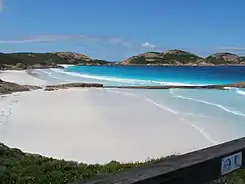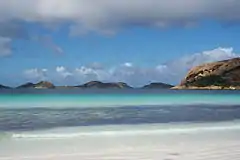Lucky Bay
Lucky Bay is a bay located at 33°59′40″S 122°13′57″E[1] on the south coast of Western Australia, in the Cape Le Grand National Park.[2] Located south-east of Esperance, the bay is a tourist spot known for its bright white sands and turquoise-coloured waters.

History

Matthew Flinders had sailed into the hazardous Archipelago of the Recherche, and found his ship surrounded by islands and rocks with nightfall coming on. He named this area "Lucky Bay" when his vessel HMS Investigator took refuge after a summer storm.[3] Recounting the adventure, he wrote the following:
"The chart alone can give any adequate idea of this labyrinth of islands and rocks.... Seeing no probability of reaching a space of clear water in which to stand off and on during the night, and no prospect of shelter under any of the islands, I found myself under the necessity of adopting a hazardous measure; and with the concurrence of the master's opinion, we steered directly before the wind for the main coast, where the appearance of some beaches, behind other islands, gave a hope of finding anchorage. At seven in the evening we entered a small sandy bay; and finding it sheltered everywhere except to the south-westward, in which direction there were many islands and rocks in the offing to break off the sea, the anchor was dropped in 7 fathoms, sandy bottom. The master sounded round the ship, but nothing was found to injure the cables; and except the water being shallow in the north-west corner of the bay, there was no danger to be apprehended, unless from strong south-west winds. The critical circumstance under which this place was discovered induced me to give it the name of Lucky Bay."[4]
Geography
In 2017 it was scientifically tested as having the whitest sand in Australia, possibly the world, knocking Hyams Beach in NSW off its perch. Lucky Bay was ahead of Hellfire Bay and Tallebudgera Creek Beach in Queensland, with Hyams Beach coming at fifth place. The test was conducted by soil science consultant Noel Schoknecht. Samples were amassed from the top 10cm in the "active zone" between the water and the sand dunes. Schoknecht said the whitest sands are usually made up of fine grains of milky or frosted quartz and a lack of adulteration.[5]
Tourism
The beach is known for its pure white sand and clear tranquil waters bay. It is ideal for swimming, snorkelling, fishing, surfing, launching small boats and also for camping and whale watching. Nearby there are solar powered showers and public toilets. Kangaroos may be present in the beach area.
Gallery
See also
- Whitehaven Beach, a white sandy beach in Queensland
- Hyams Beach, a beach in New South Wales also with white sand
References
- "Lucky Bay". Gazetteer of Australia Online. Geoscience Australia. Archived from the original on 9 October 2012. Retrieved 25 July 2010.
- http://parks.dpaw.wa.gov.au/site/lucky-bay
- Estensen, Miriam (2002). The life of Matthew Flinders. Crows Nest: Allen & Unwin. p. 185. ISBN 1-74114-152-4.
- Flinders, Matthew (1814). A Voyage to Terra Australis.
- Lucky Bay crowned Australia’s whitest beach



